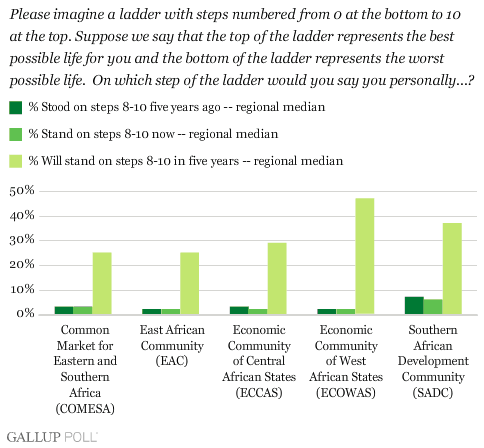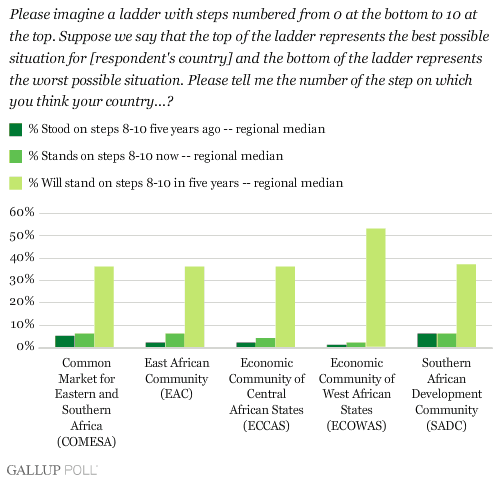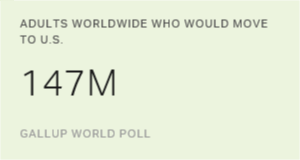WASHINGTON, D.C. -- The dream of a United States of Africa, as envisioned by the continent's leaders at independence, has yet to be realized. But in the blueprints for African unity, economic cooperation among the continent's diverse regions has emerged as a key element to foster development and economic growth and ultimately, improve the lives of Africa's more than 900 million people. Many of the building "blocs" that will serve as the pillars of economic integration are already in place. Known as Regional Economic Communities (RECs), these trade blocs serve to strengthen economic, political, and social cooperation among member states. The goal of policy coordination and trade ties among the RECs is to create a continent-wide economic union by 2027.
Gallup in 2006 polled respondents in 25 REC-member countries to measure anticipation of progress in sub-Saharan Africa. Despite the tremendous challenges that most individuals in the region face, a great sense that a better life lies ahead pervades the regional trade blocs. Looking across each of the blocs surveyed, at least a regional median of one-quarter of respondents believe they, personally, will be better off just five years from now.
As it does around the world, Gallup asked respondents to rate the status of their lives and their countries using the Cantril Self-Anchoring Striving Scale with steps numbered from 0 to 10, where "0" indicates the worst possible life and "10" the best possible life. Percentages of respondents rating the status an 8, 9, and 10 are combined to represent the top of the ladder on this measure. Gallup specifically asked respondents which steps they stood on five years ago, where they stand now, and where they expect to stand five years from now. Top-of-the-ladder median scores were calculated for each REC, including polling data for countries that are members of more than one bloc.
High Hopes for the Future
Across five active regional blocs, medians of fewer than 1 in 10 respondents in each bloc place their past and present lives on steps 8 through 10 of the ladder, but at least a median of one-quarter of respondents expect to stand at the top of the ladder five years from now. Respondents in the West African bloc (ECOWAS) express the highest level of optimism, where a regional median of 47% expect to stand at the top of the ladder in the future, compared with a regional median of just 2% today. Respondents in other economic blocs also express great hope for a better personal life in the future, but the median scores in those regions are not as high.

When respondents are asked about their country's future, results show a similar pattern. In each region surveyed, medians of fewer than 1 in 10 respondents place their past and current country's situation at the top of the ladder, but at least a median of 36% of respondents think their country will reach that level in five years. West Africans express the greatest hopes for their countries, as a regional median of 53% of ECOWAS respondents expect their nations to reach the top of the ladder in five years, while a median of just 2% believe their countries are at that level today. In the other economic blocs, progress is anticipated, but the median scores in those regions are lower.

While Gallup Poll research around the world finds many world citizens expressing optimism about their futures, some of the greatest anticipation (as measured by the gap between present and future standings) is found in sub-Saharan Africa. Across all five economic regions, the difference between regional median ratings of respondents' present and future status ranges from 22 points in the Eastern and Southern Africa bloc (COMESA) to 45 points in the West Africa sub-region (ECOWAS).
Survey Methods
Results are based on face-to-face interviews with 1,000 adults, aged 15 and older, which were conducted throughout 2006. The polls were conducted in the following countries: Burundi, Ethiopia, Kenya, Madagascar, Malawi, Rwanda, Uganda, Zambia, and Zimbabwe in the Common Market for Eastern and Southern Africa (COMESA); Burundi, Kenya, Rwanda, Tanzania, and Uganda in the East African Community (EAC); Angola, Burundi, Cameroon, Chad, and Rwanda in the Economic Community of Central African States (ECCAS); Benin, Burkina Faso, Ghana, Mali, Niger, Nigeria, Senegal, Sierra Leone, and Togo in the Economic Community of West African States (ECOWAS); and Angola, Botswana, Madagascar, Malawi, Mozambique, South Africa, Tanzania, Zambia, and Zimbabwe in the Southern African Development Community (SADC).
For results based on the total sample of national adults, one can say with 95% confidence that the maximum margin of sampling error is ±5 percentage points. In addition to sampling error, question wording and practical difficulties in conducting surveys can introduce error or bias into the findings of public opinion polls.
